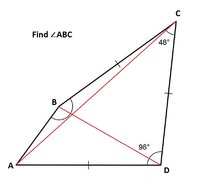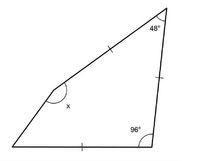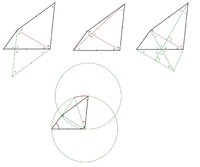This one made me mad
- Thread starter Farzin
- Start date
Steven G
Elite Member
- Joined
- Dec 30, 2014
- Messages
- 14,587
If you labelled the points for us we can then communicate better.
Draw a line from angle x to the angle labelled 96o.
Also draw the other diagonal.
You know by now that we do not supply answers on this forum but will help you arrive at the answer by giving leading hints.
Please draw the line I suggested and update the figure as much as you can. This way we have something to continue with. Also, please label all the vertices.
Draw a line from angle x to the angle labelled 96o.
Also draw the other diagonal.
You know by now that we do not supply answers on this forum but will help you arrive at the answer by giving leading hints.
Please draw the line I suggested and update the figure as much as you can. This way we have something to continue with. Also, please label all the vertices.
Last edited:
I have tried to solve it by drawing those two lines and make an isosceles triangle but didn't succeed.If you labelled the points for us we can then communicate better.
Draw a line from angle x to the angle labelled 96o.
Also draw the other diagonal.
You know by now that we do not supply answers on this forum but will help you arrive at the answer by giving leading hints.
Please draw the line I suggested and update the figure as much as you can. This way we have something to continue with. Also, please label all the vertices.

Otis
Elite Member
- Joined
- Apr 22, 2015
- Messages
- 4,592
Hi Farzin. Please show some of your work. There are different ways to find xº; some use Law of Cosines and Law of Sines.I've been working on this problem for days …
The diagram shows three congruent sides; let symbol y represent that length. Name the intersection of the two (red) diagonals as point E.
One approach could be finding distance AC in terms of y, by applying the Law of Cosines.
Triangle ACD is isosceles, so angle measures for CAD and ACD are easily calculated.
At this point, you could solve for y, after using Law of Sines to write an equation.
Continue solving for lengths/angles, to get measures for angles ABD and CBD. They sum to xº.
Perhaps, you already tried a similar approach. Can you show us?
?
Hello Otis, thanks for your suggestions, yes I have tried that before, One approach is to use the sine rule in triangle BCD and find BD then use the cosine rules for triangle ABD. But it gets too messy and I think there must be a very smart geometrical solution for this problem.
Otis
Elite Member
- Joined
- Apr 22, 2015
- Messages
- 4,592
I never learned many theorems/corollaries from classical geometry (if those are what you're thinking about). You could be correct, but I have to rely on what I learned in algebra and trigonometry classes, heh.… there must be a very smart geometrical solution …
If you find a clever solution, please post it for others to see. Cheers!
?
Otis
Elite Member
- Joined
- Apr 22, 2015
- Messages
- 4,592
Because I suffered another TIA?… why is triangle ACD equilateral? …
I will fix my vocabulary mistake. Thank you.
?
Ahh. I think I have those now daily.Because I suffered another TIA?
I will fix my vocabulary mistake. Thank you.
?
Angles CBD and CDB are 66° and also angles CAD and ACD are 42°. Finding these angles are the first things that come to the mind, but what then? It is not as easy as it looks like, I have spent hours and used many different tricks that I knew without any luck.You have some isosceles triangles each with a known angle, meaning you should know many other angles. Please update the triangle with that information.
For example what is measure of angles CBD and CDB. Do you know any others?
Yes I did try law of sines and cosines as I've mentioned above but there must be a geometrical solution to this problem. Labeling other angles leads me to nowhere, Do you have any solution?Label some more angles.
Did you try law of sines and cosines?
Steven G
Elite Member
- Joined
- Dec 30, 2014
- Messages
- 14,587
Yes, I have a solution. However, on this forum we prefer for the student to figure out the solution with our help. Can you please post the most update diagram and any work that you did.Yes I did try law of sines and cosines as I've mentioned above but there must be a geometrical solution to this problem. Labeling other angles leads me to nowhere, Do you have any solution?
If your solution is a geometrical solution then it would be fantastic but if it is a trigonometry solution I should say that it is a very obvious solution and I already have it. I spent hours and drew many different diagrams on this problem just to find it's geometric solution, I'm sure there is not enough room to post all of the drawings here. In this forum I didn't ask for solution and I know people should figure out the solution by their own, as you can see I just asked for hints. If there is no problem I can post all my diagrams in here. If you really have a geometric solution then please tell me the first step and I hope I can do the rest by myself, but so far your hints were just about angle chasing which I already have done it many many times before. Thanks!Yes, I have a solution. However, on this forum we prefer for the student to figure out the solution with our help. Can you please post the most update diagram and any work that you did.
Last edited:
Steven G
Elite Member
- Joined
- Dec 30, 2014
- Messages
- 14,587
In terms of you saying that all my hints were about chasing angles, you are correct. I just wanted us on the same page before we moved on. Was that unreasonable? However you refused to post a simple updated diagram of what you had.
Last edited by a moderator:
I am not refusing to post all my works at all, I already said that I am willing to post all the diagrams if there is enough space in here.In terms of you saying that all my lints were about chasing angles, you are correct. I just wanted us on the same page before we moved on. Was that unreasonable? However you refused to post a simple updated diagram of what you had.


